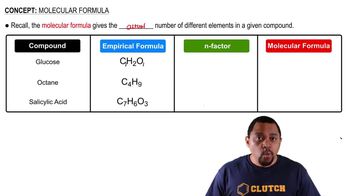Determine the empirical formulas of the compounds with the following compositions by mass: c. 62.1% C, 5.21% H, 12.1% N, and the remainder O
Ch.3 - Chemical Reactions and Reaction Stoichiometry
Chapter 3, Problem 51
What is the molecular formula of each of the following compounds? (a) empirical formula CH, molar mass 5 78.0 g/mol (b) empirical formula NH2Cl, molar mass = 51.5 g/mol
 Verified step by step guidance
Verified step by step guidance1
1. First, calculate the molar mass of the empirical formula NH2Cl. The molar mass of nitrogen (N) is approximately 14 g/mol, hydrogen (H) is approximately 1 g/mol, and chlorine (Cl) is approximately 35.5 g/mol. So, the molar mass of NH2Cl is 14 g/mol + 2(1 g/mol) + 35.5 g/mol.
2. Next, divide the given molar mass of the compound (51.5 g/mol) by the molar mass of the empirical formula you calculated in step 1. This will give you a ratio.
3. If the ratio is close to 1, then the empirical and molecular formulas are the same. If the ratio is a whole number other than 1, multiply each subscript in the empirical formula by this number to get the molecular formula.
4. If the ratio is not a whole number, it should be close to a simple fraction (1/2, 1/3, 2/3, etc.). Multiply each subscript in the empirical formula by the denominator of this fraction to get the molecular formula.
5. Always check your final molecular formula to make sure it makes sense. The molar mass of your molecular formula should be equal to the given molar mass of the compound.

Verified video answer for a similar problem:
This video solution was recommended by our tutors as helpful for the problem above.
Video duration:
2mWas this helpful?
Key Concepts
Here are the essential concepts you must grasp in order to answer the question correctly.
Empirical Formula
The empirical formula represents the simplest whole-number ratio of atoms in a compound. For example, the empirical formula NH2Cl indicates that for every one nitrogen atom, there are two hydrogen atoms and one chlorine atom. It does not provide information about the actual number of atoms in a molecule, which can be determined by the molecular formula.
Recommended video:
Guided course

Empirical vs Molecular Formula
Molecular Formula
The molecular formula gives the actual number of each type of atom in a molecule of a compound. It can be derived from the empirical formula by multiplying the subscripts by a whole number, known as the molecular weight factor. In this case, the molecular formula can be determined by comparing the molar mass of the compound to the molar mass of the empirical formula.
Recommended video:
Guided course

Determining Molecular Formulas
Molar Mass
Molar mass is the mass of one mole of a substance, typically expressed in grams per mole (g/mol). It is calculated by summing the atomic masses of all atoms in the molecular formula. For the compound with an empirical formula of NH2Cl and a given molar mass of 51.5 g/mol, this value is crucial for determining the molecular formula by comparing it to the molar mass of the empirical formula.
Recommended video:
Guided course

Molar Mass Concept
Related Practice
Textbook Question
Textbook Question
A compound whose empirical formula is XF3 consists of 65% F by mass. What is the atomic mass of X?
Textbook Question
The compound XCl4 contains 75.0% Cl by mass. What is the element X?
Textbook Question
What is the molecular formula of each of the following compounds? (a) empirical formula HCO2, molar mass = 90.0 g/mol
1
views
Textbook Question
What is the molecular formula of each of the following compounds? (b) empirical formula C2H4O, molar mass = 88.0 g/mol
1
views
Textbook Question
Determine the empirical and molecular formulas of each of the following substances: (a) Styrene, a compound used to make Styrofoam® cups and insulation, contains 92.3% C and 7.7% H by mass and has a molar mass of 104 g/mol.
